13 Types Of GREY Birds With YELLOW Bellies (ID Guide w Photos)
Did you recently come across a grey bird with a yellow belly, and want to know what species it was?
Identifying grey-colored birds with yellow bellies is not as easy as it might seem, since there are surprisingly many bird species in North America that fit this description.
To help you identify the bird you saw, we’ll cover the most common grey birds with yellow bellies in North America.
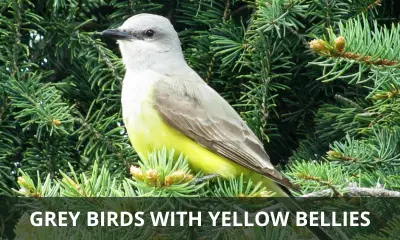
What species of birds are grey with a yellow belly?
There are 13 species of birds in North America that are grey and have a yellow belly, which are covered in full detail below.
Now let’s dive into the details, and start with the most common species:
Western Kingbird
Scientific name: Tyrannus verticalis
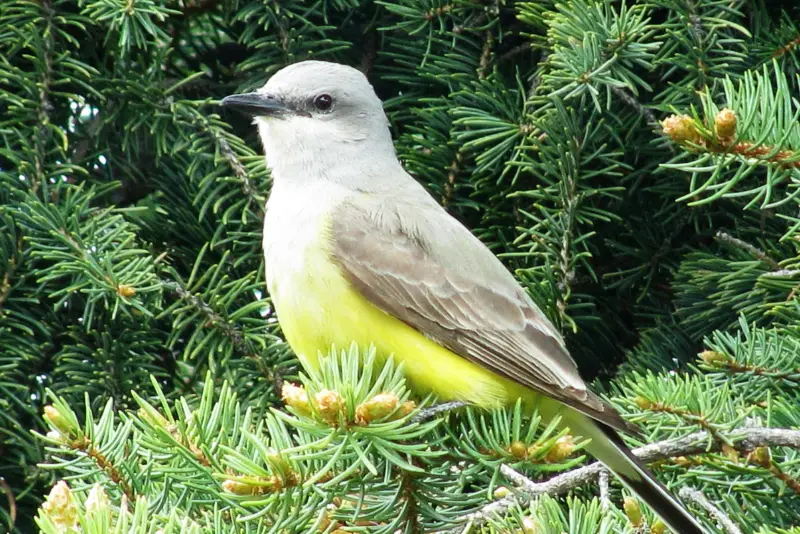
The Western Kingbird is a pale grey bird with a yellow underside, and both sexes look broadly similar.
Adults have a head that is mostly a light grey color, with a thin black line that runs through each eye.
The feathers of their dark brown wings have light colored edges, as do the tail feathers. Young birds resemble adults but are paler.
The Western Kingbird is a summer visitor that breeds throughout the western parts of the United States, and can be seen from April through August. It winters in Central America.
The preferred habitat of this grey colored bird is farmland and open country mixed with woodlands.
Common Yellowthroat
Scientific name: Geothlypis trichas
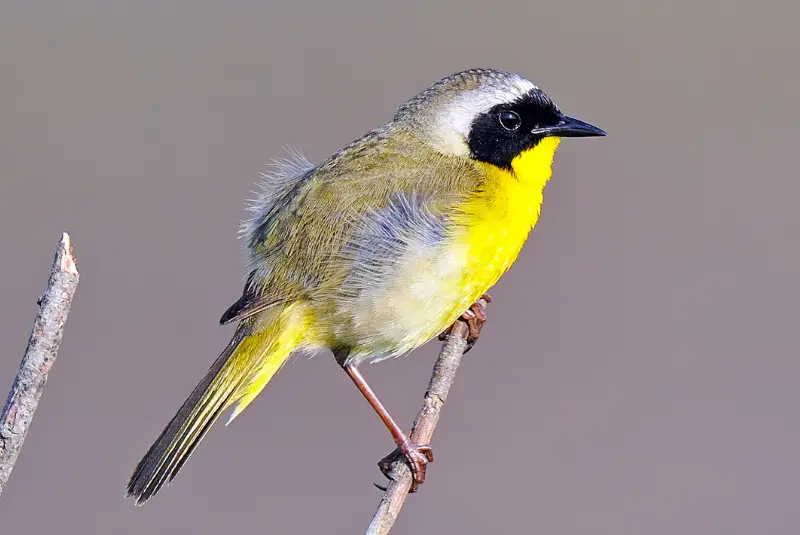
Common Yellowthroats are small songbirds with a brightly colored plumage. Adult males have a vivid yellow throat and chest, as well as a broad black mask that covers the forehead and cheeks.
Their black face mask is bordered on top by a grey and white band, which transitions into the olive brown nape and back. Females are similar, but lack the black face mask.
This grey warbler is present throughout northern North America during the summer, and winters in the southern United States from September through March.
The Common Yellowthroat prefers shrubland and grassy habitats, and feeds on insects and other invertebrates.
Yellow-breasted Chat
Scientific name: Icteria virens

These birds are between the size of a sparrow and a robin. They are olive-grey on top with a bright yellow belly and breast, a grey head and face, and a distinct white eyebrow stripe.
Yellow-breasted Chats are present as common breeding birds throughout North America during the months of May through August.
They can usually be found in dense areas such as thickets, bramble bushes, shrubs, and along streams.
The diet of this grey bird consists of small insects, such as moths, beetles, ants, and grasshoppers. They also eat berries such as wild grapes and elderberries.
Canada Warbler
Scientific name: Cardellina canadensis
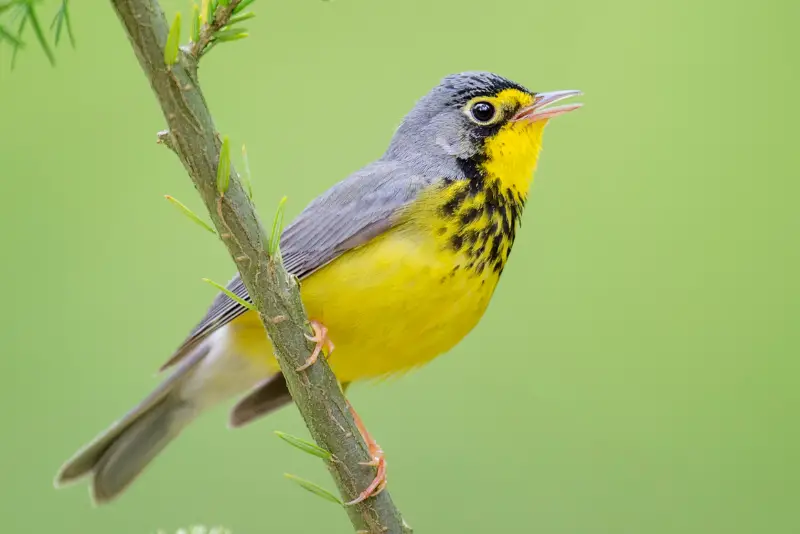
The Canada Warbler is a vibrant small songbird that may be found as a breeding bird in Canada and northern states of the eastern USA.
The sexes look different, but both have blue-grey upperparts and a bright yellow belly. Adult males also have a band of dark streaks that divides the throat from the breast.
The Canada Warbler is a migratory bird that can be seen on its passage through eastern North America in spring and fall.
This grey and yellow warbler favors damp forests with plenty of undergrowth, and is often found near water. It winters in South America.
Pine Warbler
Scientific name: Setophaga pinus
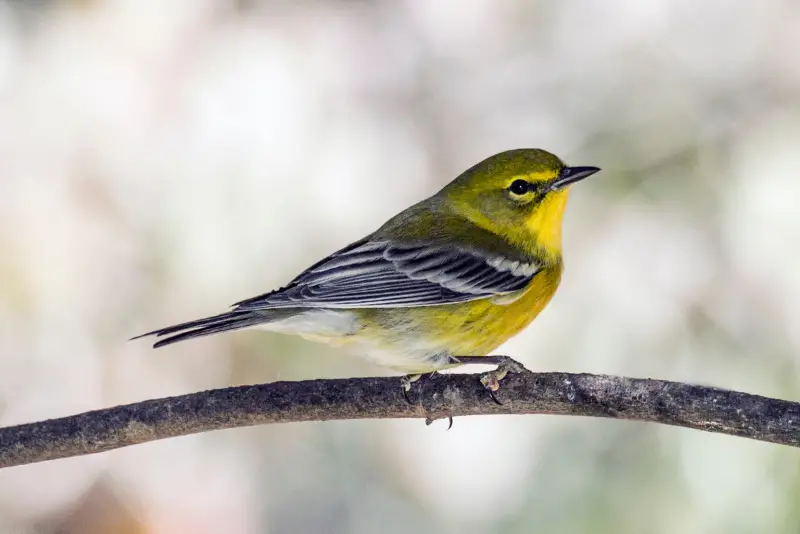
The Pine Warbler is almost always found in the vicinity of pine trees, which explains how it got its name.
Adult males have olive grey upperparts and bright yellow underparts, while the females are more greyish buff.
During the months of April through September, the Pine Warbler may be encountered nesting in the woods of eastern North America.
It also winters in southeastern parts of the United States, and forages in the underground of pine forests, which makes it relatively easy to observe.
Magnolia Warbler
Scientific name: Setophaga magnolia
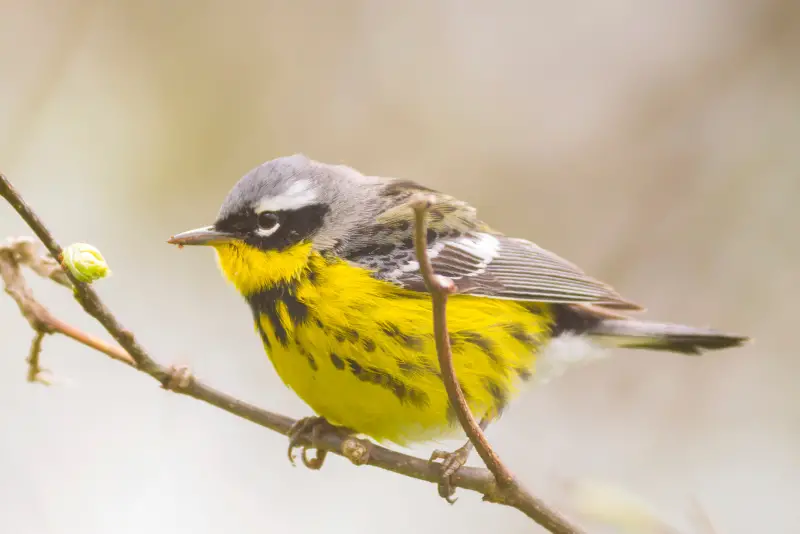
Adult males of this colorful bird have dark upperparts and bright yellow belly with a distinctive black chest band and dark streaks on the flanks.
The crown is blueish grey with a black mask demarcating the head from the light throat.. Females look similar, but lack the areas of black plumage.
The Magnolia Warbler is a breeding bird of the northeastern parts of North America, but can also be seen on passage throughout the eastern United States during spring and fall migration.
It favors coniferous forests, where it forages for insects and other invertebrates in the dense undergrowth.
Nashville Warbler
Scientific name: Oreothlypis ruficapilla
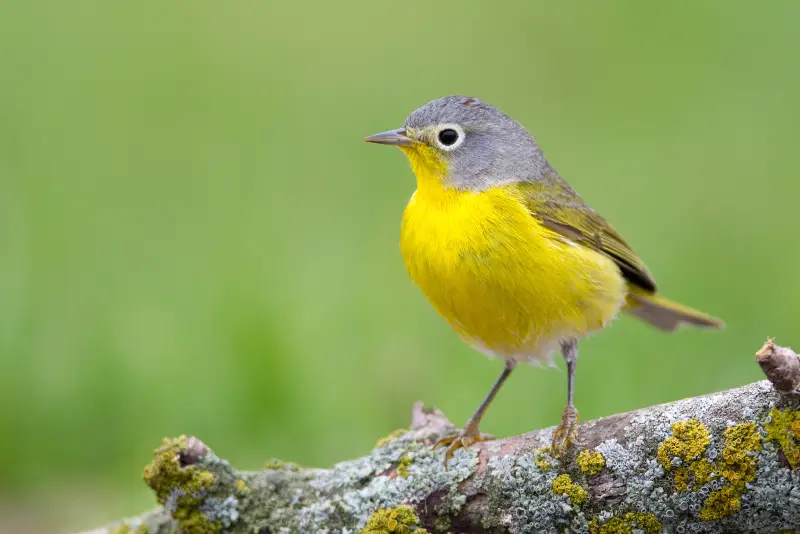
The Nashville Warbler is a beautiful little songbird. Adult males have an olive grey back, a blue grey head, and lemon yellow belly.
Females and juvenile birds are similar to males, but have slightly paler yellow and are less colorful overall.
The Nashville Warbler is a breeding bird of Canada and the northernmost United States, but is also encountered as a migratory bird throughout the United States during spring and fall.
Similar to many other warblers, it migrates to Central America in order to spend the winter. It favors the tangled undergrowth of mixed forests.
MacGillivray’s Warbler
Scientific name: Geothlypis tolmiei

MacGillivray’s Warblers look similar to Mourning Warblers, but are a species of higher altitudes. Adult males have a blue-grey hood that contrasts with their bright yellow bellies.
Females and juveniles are more drab, and have a pale grey hood. These yellow-bellied birds are present in western North America during the summer months from June through August.
This grey colored warbler favors forests with dense undergrowth, and winters in Central America.
Cassin’s Kingbird
Scientific name: Tyrannus vociferans
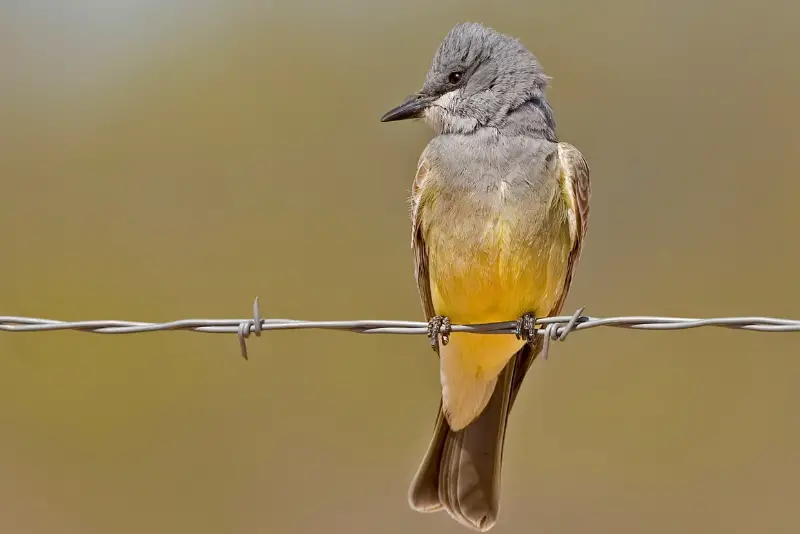
Cassin’s Kingbird can be distinguished from its close relative the Western Kingbird primarily through coloration.
It has darker-toned colors than the latter, including its head, back and chest which appear dark greyish in nature, contrasting with its bright yellow belly and a white throat cape mainly visible on adults.
The Cassin’s Kingbird breeds in the southwestern United States, and is found at higher elevations such as mountainous woodland zones across territories.
Most will then fly off to winter in Mexico while a few stay in Southern California during the cold months.
Tropical Kingbird
Scientific name: Tyrannus melancholicus

Compared to other members of the genus Tyrannus, the Tropical Kingbird is characterized by its paler appearance, disproportionately large bill, short wings, and forked tail.
Adult males and females look similar, and have a grey head with a dark mask, greenish-grey back, as well as a dull yellow breast, and a bright yellow belly.
The Tropical Kingbird’s main range is outside the United States, with the exception of southern Arizona (where it is a summer visitor from April to August), and the lower Rio Grande Valley of Texas (where it is seen year-round).
Couch’s Kingbird
Scientific name: Tyrannus couchii
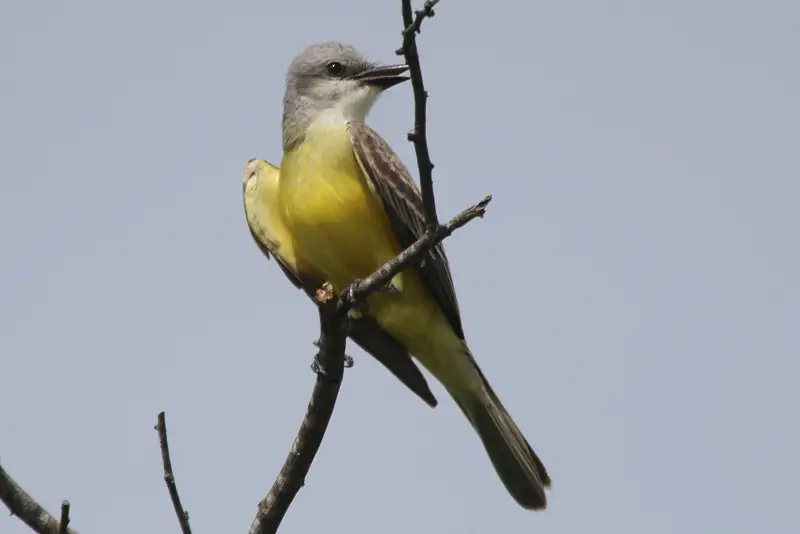
This is a large flycatcher with beautiful hues of yellow and grey that closely resembles the Tropical Kingbird in appearance – though their upper parts tend to appear slightly greener and they sport shorter bills compared to the latter species.
Listening to the sounds of these yellow-bellied birds plays a crucial role in distinguishing between them based on their distinct calls.
Often found primarily within South Texas; however; their range has been extending slowly along other areas of Gulf Coast over time.
Lightly wooded habitats such as thorn forests or stream edges and even suburban areas tend to attract Couch’s Kingbird more compared to Tropical ones which occupy open spaces.
American Redstart (Female)
Scientific name: Setophaga ruticilla

While male American Redstarts are orange and black, females have yellow plumage instead of the orange parts of the male.
Females also have much less black, and as a result look like pale green birds with bright yellow patches.
This grey colored bird breeds in the northern parts of North America from May through August, and favors a wide variety of woodland habitats, as well as backyards.
It migrates to South America to spend the winter months.
Great Crested Flycatcher
Scientific name: Myiarchus crinitus

The Great Crested Flycatcher is a slim, long-bodied flycatcher. Adults have a dark grey head and back, as well as a yellowish belly.
The tail is rufous orange, and the crest of this grey bird is relatively small, and not very useful as a distinguishing feature.
The Great Crested Flycatcher is a common bird in the eastern half of North America during the summer, where it can be seen from April through September.
It nests in a wide variety of woodland habitats, and feeds on insects as well as berries. Its winter range extends from Central to South America.
Final remarks
In summary, here are the 13 types of grey birds with yellow bellies found in North America:
- Western Kingbird
- Common Yellowthroat
- Yellow-breasted Chat
- Canada Warbler
- Pine Warbler
- Magnolia Warbler
- Nashville Warbler
- MacGillivray’s Warbler
- Cassin’s Kingbird
- Couch’s Kingbird
- Tropical Kingbird
- American Redstart (female)
- Great Crested Flycatcher
If you’ve spotted one of these yellow-bellied birds while bird watching, but aren’t sure which species it was, check our detailed ID guide with photos above.
If you enjoyed this article, check out our guide to the types of yellow birds found in Michigan.
